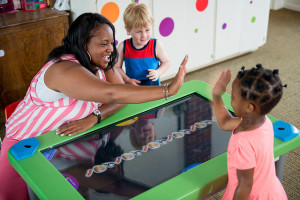
Photo Credit: Texas A&M University Co
Many parents and educators find it difficult to understand and talk to kids about their involvement with video games and other digital technologies. This is particularly true for parents and teachers who did not grow up amidst ever-present computers and video games. Mark Prensky, a popular writer on technology, describes these individuals born before 1980 as “digital immigrants.” Parents born after 1980 are considered to be “digital natives” in that they grew up with computers, video games, and other digital technologies as a prominent part of their lives. Due to their lack of understanding, many “digital immigrants” neglect the potential benefits of digital technologies regarding the growth and development of our children.
When actually considered, it is quite amazing that parents and teachers know so little about what their kids are doing for 7 to 10 hours a day. That’s right–in 2010, the Kaiser Foundation determined that children ages 8 to 18 use digital media for an average of 7 hours, 38 minutes a day, and for more than 10-1/2 hours a day if one takes into account their multitasking! If our children spent this much time playing sports, engaging in the latest dance craze, or writing poetry, then we would surely be asking questions, trying to transform these activities into useful experiences for them. However, the use of digital technologies is often alien to adults; instead, children are the experts here, and many parents seem reluctant to even communicate about these activities.
For many parents, communicating with their children about video games simply consists of setting limits, and, certainly, limits need to be set for most children. Children also need to be encouraged to engage in alternative activities. At the same time, however, there are many opportunities for discussions about making digital-technology use productive.
General strategies for parents to improve communication with their children, particularly about using digital technologies, include:
- Play games with your kids.
The best way to know what your kids are doing is to do it with them. Most children will be interested in showing you how to play the games and teaching you gaming skills. Conversations during these times can be very fruitful, particularly if you encourage your children to articulate the problem-solving and thinking skills that they use during game play.
- Ask your children to tell you about their favorite games.
Find out what types of games they like and why they enjoy them. Ask them about the technologies that they enjoy the most.
- Discuss limit-setting on technology use with your children.
Rather than setting arbitrary limits, talk to your children about the need for their being engaged in a range of healthy play activities. These include physical play, social play, creative and imaginative play, artistic and musical play, and nature-based play. Ask your children how much time they think they should be allowed to engage in video game play and other digital-technology use.
- Ask children what they are learning from their video game and technology play.
You might be surprised to hear how much they are learning from searching the Internet or using Facebook. Many video games present realistic views of history, such as world wars and past civilizations. Encourage children to play such games through which they can acquire historical or scientific knowledge.
- Encourage challenging and varied game play.
If you find that your children are devoted to playing one game, then it may be useful to set limits on how much time they can play that particular game while encouraging them to play other types of games in order to expand their range of interest and to increase the potential for learning through game play.
Receive online class information and helpful tips from Dr. Randy Kulman's LearningWorks for Kids |



